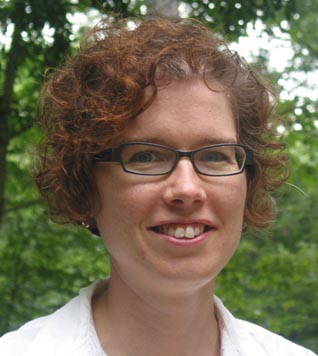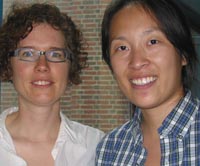Why Can’t We Remember That Word?
Wellesley’s Jennie E. Pyers Studies ‘Tip of the Tongue’ Experiences
FOR IMMEDIATE RELEASE:
October 18, 2009 |
|
 |
WORD PLAY: Wellesley psychology professor Jennie E. Pyers studies language and cognitive development in part through foibles such as "tip of the tongue" flubs.
(Click image for print quality photo.) |
WELLESLEY, Mass. – Wellesley College psychologist Jennie E. Pyers would like to tell you about her latest research – it’s right on the tip of her tongue. Pyers studies that all-too-human tendency to try to say a word you know, but just can’t remember.
Her research looks for possible explanations for this lapse: “One, words that sound the same are competing to come out,” says the assistant professor. “Two, words that share the similar meaning will block out another word. Or three, words that we don’t use very often are harder to access.”
Pyers’ research team decided to study the phenomenon by comparing bilingual people who speak two languages (Spanish and English) with bilinguals who use English and American Sign Language (ASL). Since signers make no use of sound to communicate, they eliminate the option that sound-alike words will bring about a tip-of-the-tongue incident.
To provoke tip-of-the-tongue moments, the researchers showed a group of Spanish-English bilinguals, and a group of English-only speakers, pictures of dozens of objects, asking them to name each within 30 seconds. The objects were not your run-of-the-mill table or chair – rather, they were a weathervane or a metronome, for example.
Those people who spoke just one language had fewer tip-of-the-tongue experiences than bilinguals, making about seven flubs versus 12. And, when comparing Spanish-English bilinguals and ASL-English bilinguals, both groups had about the same number of flubs, revealing that similar-sounding words don’t cause those “just can’t remember” instances.
Pyers’ research concludes that tip-of-the-tongue experiences happen because we are trying to remember words we rarely use. Her research, conducted with Tamar H. Gollan of the University of California, San Diego, and Karen Emmorey of San Diego State University, appeared in the August issue of the journal Cognition.
HEARING DIFFERENCES: Pyers often works with signers for her research. As the hearing child of two deaf parents, she is fluent in ASL and has found a research goldmine in using deafness to better understand the mind.
She is currently conducting research with a unique community of deaf people in Nicaragua, who started to develop a new sign language in the 1970s.
“The language is only about 30 years old,” Pyers said. “In the case of Nicaraguan Sign Langauge, the language is becoming more complex in the hands of the children of the community. Children’s brains are ready to take mixed language input and turn it into a systematic language, a language that the adults of the community may find difficult to learn.”
The group of signers provided a unique opportunity to compare two sets of people with very different levels of language ability: the first generation of signers, who created the rudimentary language, and adolescent signers who had worked out a more complex system.
She uses the two groups to study the development of a “theory of mind,” which involves understanding another person's perspective and realizing that it can differ from our own. Pyers’ research indicates that the development of a theory of mind depends on language ability.
To test this, she used a “false-belief” test. For example, two children are playing with a toy. The first child puts the toy under the bed and leaves the room. The second child then takes the toy and puts it in the toy box. On returning, where will the first child look for the toy?
Children under the age of four who have a poor theory of mind will typically say the first chold will look in the toy box, while older children correctly say under the bed.
When Pyers' team gave Nicaraguan signers false belief tests, the adolescent signers were more likely to respond correctly than the older signers.
However, when the older signers learned the more complex signs used by the teens, their performance on the false-belief test improved. Pyers says this suggests that language development may be the key to developing a mature theory of mind.
“Language learning, over and above social experience, drives the development of a mature theory of mind,” said Pyers, whose study, conducted with Ann Senghas of Barnard College, was published this summer in the journal Psychological Science. “Ultimately, it shows that learning langauge is really important. Language unlocks the door to understanding others’ minds.”
 |
SPECIAL INSIGHT: Pyers, left, with Wellesley senior Annemarie Kocab, who herself is deaf. Kocab has taken part in research that employs at sign languages as a tool for understanding.
(Click image for print quality photo.)
|
FOLLOWING HER LEAD: Pyers and Wellesley College senior Annemarie Kocab of Farmington Hills, Mich., returned from a research trip to Nicaragua at the end of August. These studies hold special meaning for Kocab, who herself is deaf.
“One of the reasons why I chose to attend Wellesley was the opportunity to work with Dr. Pyers, whose research focuses largely on sign language,” said Kocab. “Although I have used sign language to communicate since I was an infant, Dr. Pyers’ research provides me with a special insight in the workings of sign language, how it is similar to spoken language, and how it is unique.”
Majoring in cognitive and linguistic science and English, Kocab is also captain of the varsity fencing team and a member of the Student-Athlete Advisory Council. With Pyers, she has conducted research at Gallaudet University in Washington, D.C., the only university dedicated to the education of deaf students, and in Nicaragua both this summer and last.
“That trip was eye-opening in many ways,” she said. “Not only was it my first time traveling outside of the States, it was also my first time around deaf users of a different sign language. Given Nicaraguan Sign Language’s fascinating history to date, it was truly the experience, both educationally and personally, of a lifetime.”
This fall, Pyers is on sabbatical from Wellesley as a 2009–2010 Radcliffe Institute fellow, where she continues her research with a project on how learning of American Sign Language has ties to cognitive development.
Since 1875, Wellesley College has been a leader in providing an excellent liberal arts education for women who will make a difference in the world. Its 500-acre campus near Boston is home to 2,300 undergraduate students from all 50 states and 68 countries. For more information, go to www.wellesley.edu.
###
|

